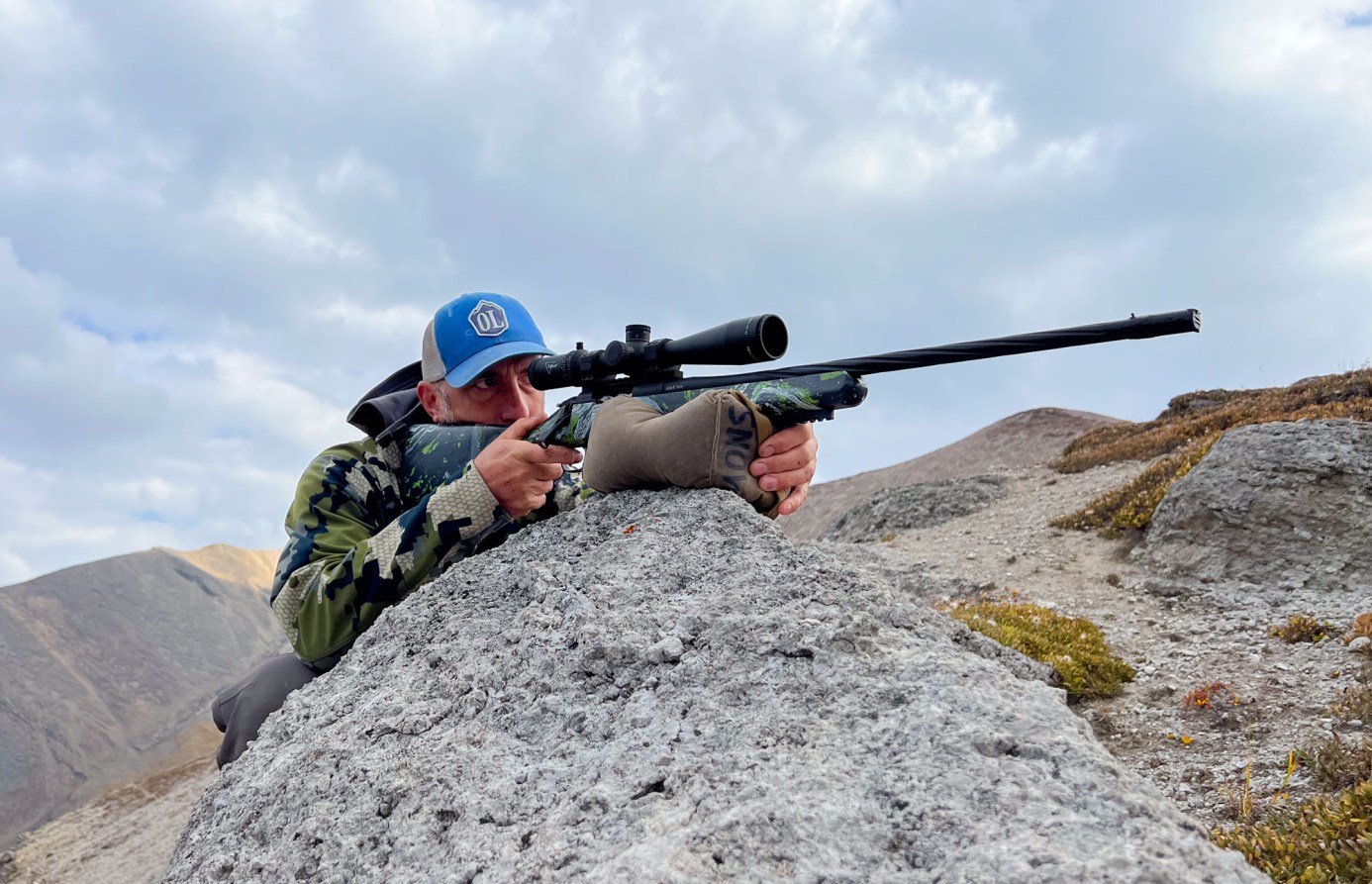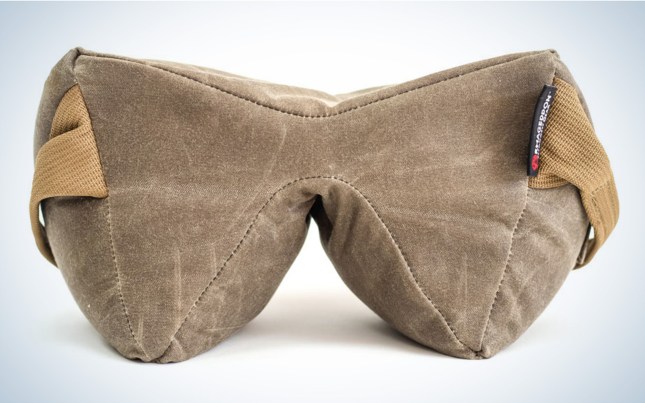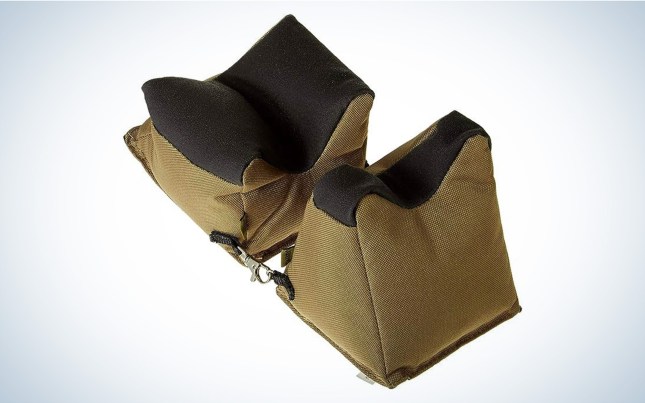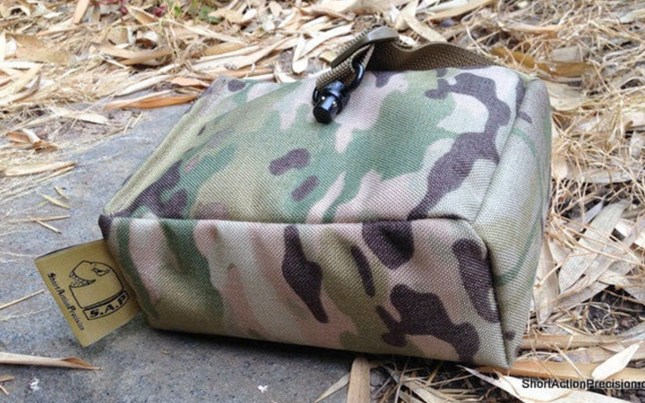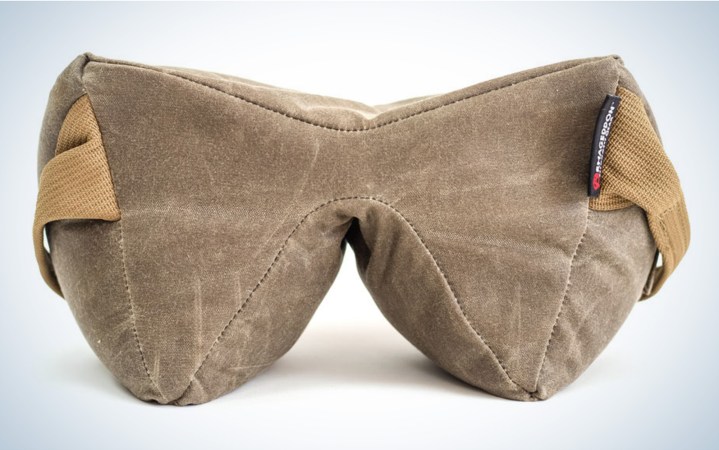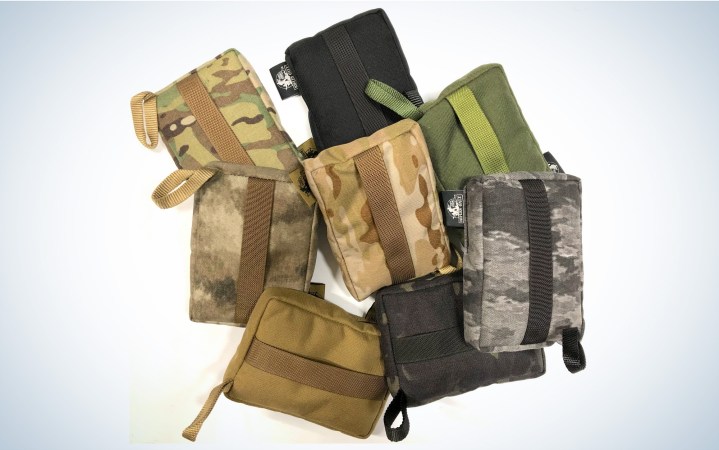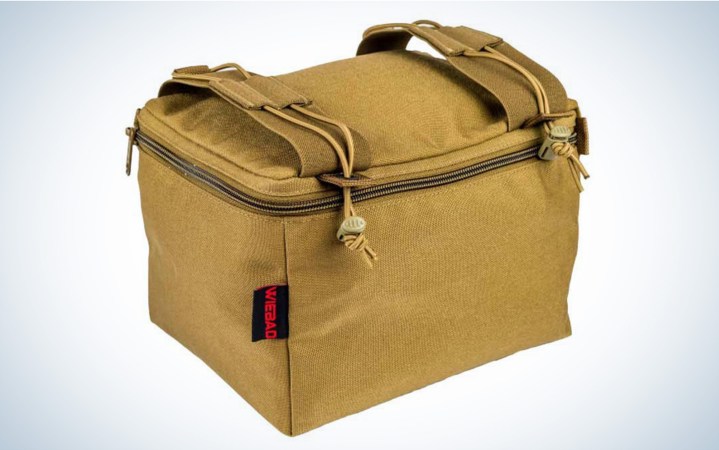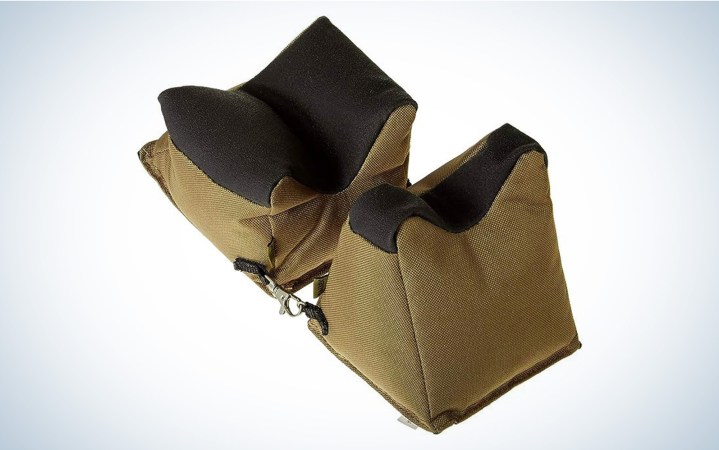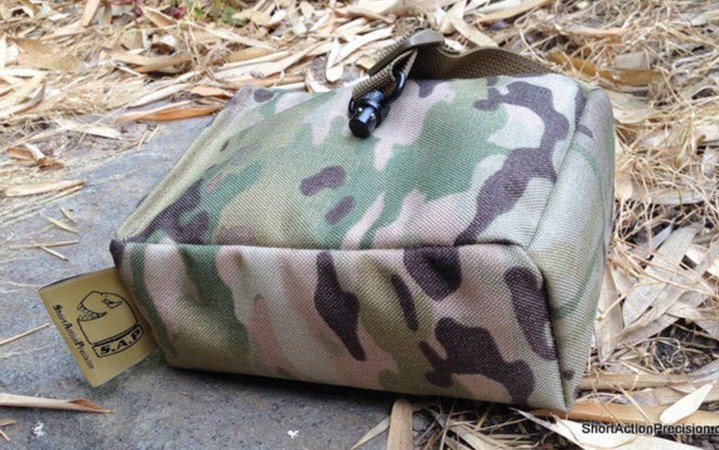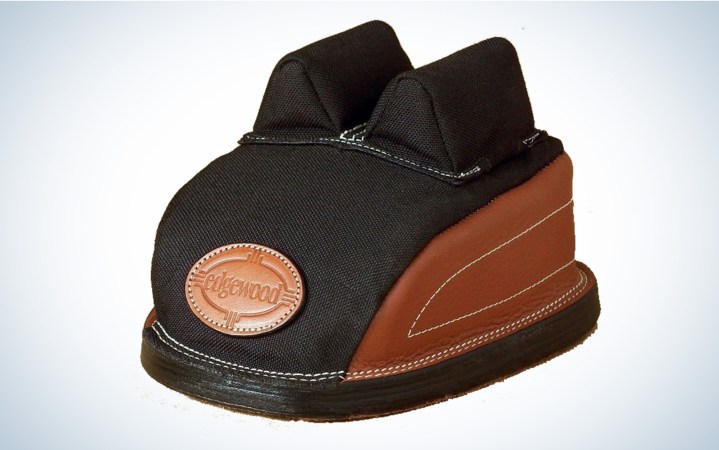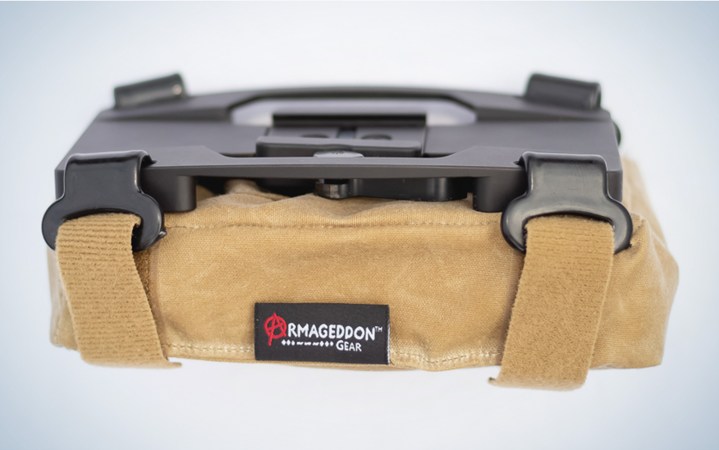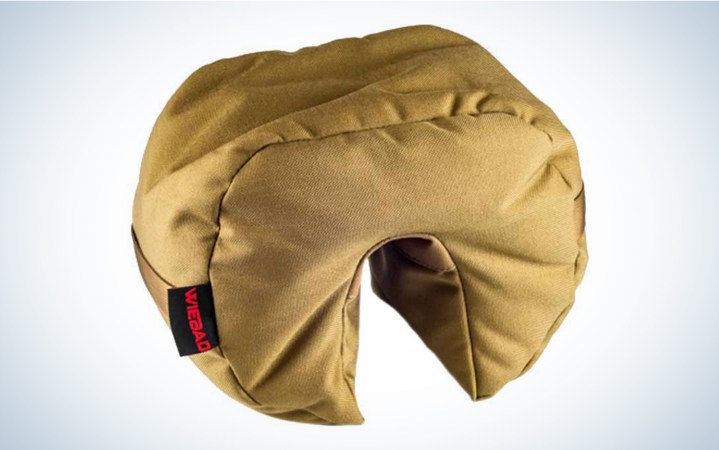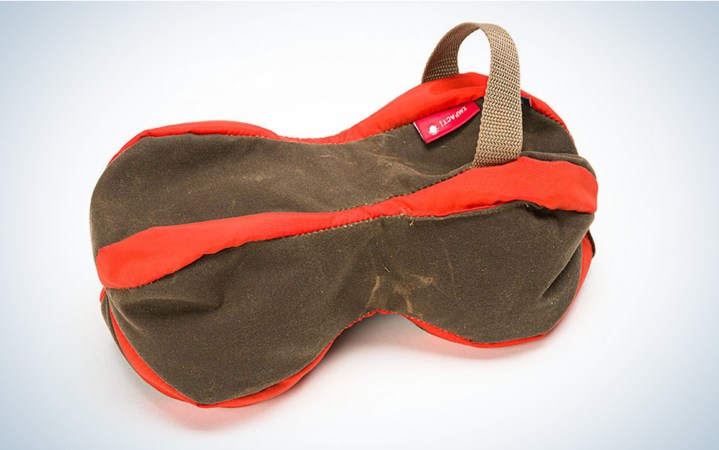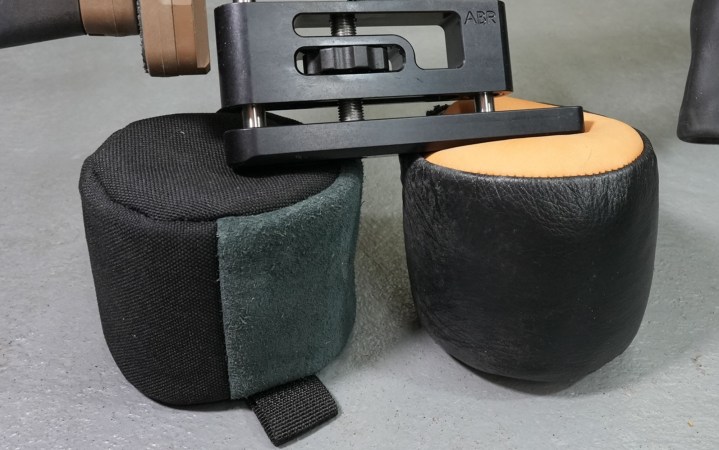We may earn revenue from the products available on this page and participate in affiliate programs. Learn More ›
I doubt that 20 years ago anyone would have anticipated the lowly shooting bag would become a category of notable innovation in the world of marksmanship. What qualified as the best shooting bag back then was pretty simple. There were a number of technical bags for sports like benchrest and F-Class that had a lot of thought put into their construction; then there were the amorphous blobs of fabric and leather stuffed with whatever was at hand—lead shot, plastic hobby-store beads, rice—that the rest of us used.
Looking back, I’m embarrassed to think that I ever considered an old sock filled with grain from my cupboard an adequate addition to my shooting kit. I won’t solicit confessions, but I know some of you are guilty of the same.
My, how things have changed.
One of the strongest structures in the word is the tripod, and the rise of the shooting bag can be attributed to three specific factors, each the leg of a metaphorical tripod. One is the revolution in the construction of rifles, ammunition, optics, and associated accessories and their contribution to off-the-shelf accuracy. The second was the primacy of snipers in the military campaigns in Iraq and Afghanistan. And third is the explosive growth in practical field marksmanship, exemplified by the Precision Rifle Series, NRL Hunter, the Nightforce ELR, and other so-called tactical and sniper competitions.
All these developments have put pressure—a very positive pressure—on shooters to improve our collective skill. We now place every item we take afield under a microscope to gain an edge.
Today’s Best Shooting Bags
This brisk Darwinian cycle of refinement has led to rapid evolution in our gear, and no example demonstrates the dynamic better than what’s happened with shooting bags.
The three elements of a shooting bag—the material in its build, the shape, and the fill—have undergone radical changes as individuals and companies strove to build a better mousetrap.
These offerings are the current state of the art.
- Best Overall: Armageddon Gear Shmedium Game Changer with Git-Lite
- Best Squeeze Bag: Rifles Only Rear Bag
- Best Pump Pillow: Wiebad Modular Pump Pillow
- Best Budget: Allen Company Outdoor Rifle Rest
- Best Ultralight: Short Action Precision Lightweight Bag
- Best for Benchrest: Edgewood Original Rear Bag
- Best Rifle-Mounted: Gray Ops Mini Gun Plate V2 and Mini Plate Pad
- Best for Use in Vehicle: Weibad DRC Fortune Cookie
- Great General Design: Satterlee Bone Bag
- Best Minimalist Rear Bag: Long Shot Precision Small Bag
How Use a Shooting Bag
There’s isn’t a wrong way to use a shooting bag, but there are specific tricks and techniques that will allow you to increase the stability of a shot. In fact, some of the methods employed are quite subtle and sophisticated, and with a bit of dedicated practice you can become notably more proficient.
Three Type of Shooting Bags
Broadly speaking, there are three categories of shooting bags: those that support the rear of the stock, those that support the entire rifle, and those designed to take up space and stabilize the shooter as well as the rifle. This last category includes pump pillows and other bean-bag-like configurations.
Within each category exist specific designs, some of which are generalized and others that are specific to a narrow type of shooting.
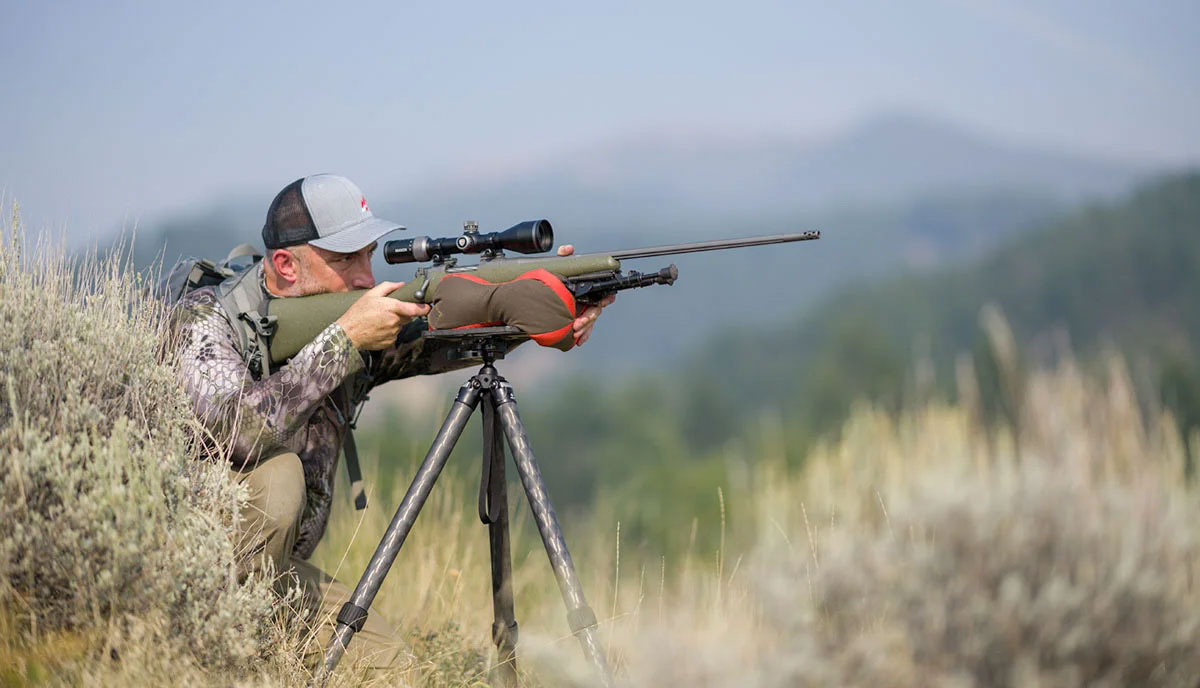
Gain Stability
In all cases, the role of the shooting bag is to support the shot and steady the shooter’s aim. The amount of stability you can expect depends on the size of the bag, the type of fill, the material used in its construction, the surface it is placed upon, and the shooter’s technique.
Read Next: Best Tripods for Hunting
Maximize Contact
When using a shooting bag, you want to maximize the contact between the rifle and bag. This imparts the greatest amount of stability. While many bags like the Game Changer and Fortune Cookie have large rabbit ears, you rarely want to put the stock between the ears. Instead, you should orient the bag so that its longest side runs in parallel with the stock. The reason for the ears on those bags is so they can conform to uneven surfaces like boulders, tree branches, fence rails, and the rails and ledges on tree blinds and box blinds.
This isn’t to say you would never run one of these bags with the ears up and on either side of the stock—one rule with shooting bags is to never say never—but generally that won’t do the best job stabilizing the shot.
Hand Position
With bags that go under the rear of the stock you usually want the off (non-trigger) hand to hold on and squeeze to adjust the crosshairs. With bags that support the whole rifle, your hand position will vary—but it is always best if you can use your non shooting hand to help stabilize the rifle.
In some cases, that means placing your hand on top of your scope, pushing the rifle down in the bag while bracing your forearm on the edge of the bag. Creating that extra contact between the forearm and bag will settle the scope’s crosshairs.
Another way to use the support hand is by reaching forward and pinching the rifle and bag together. If the bag is resting on a flat plate on a tripod, you can try pinching all three together for maximum stability.
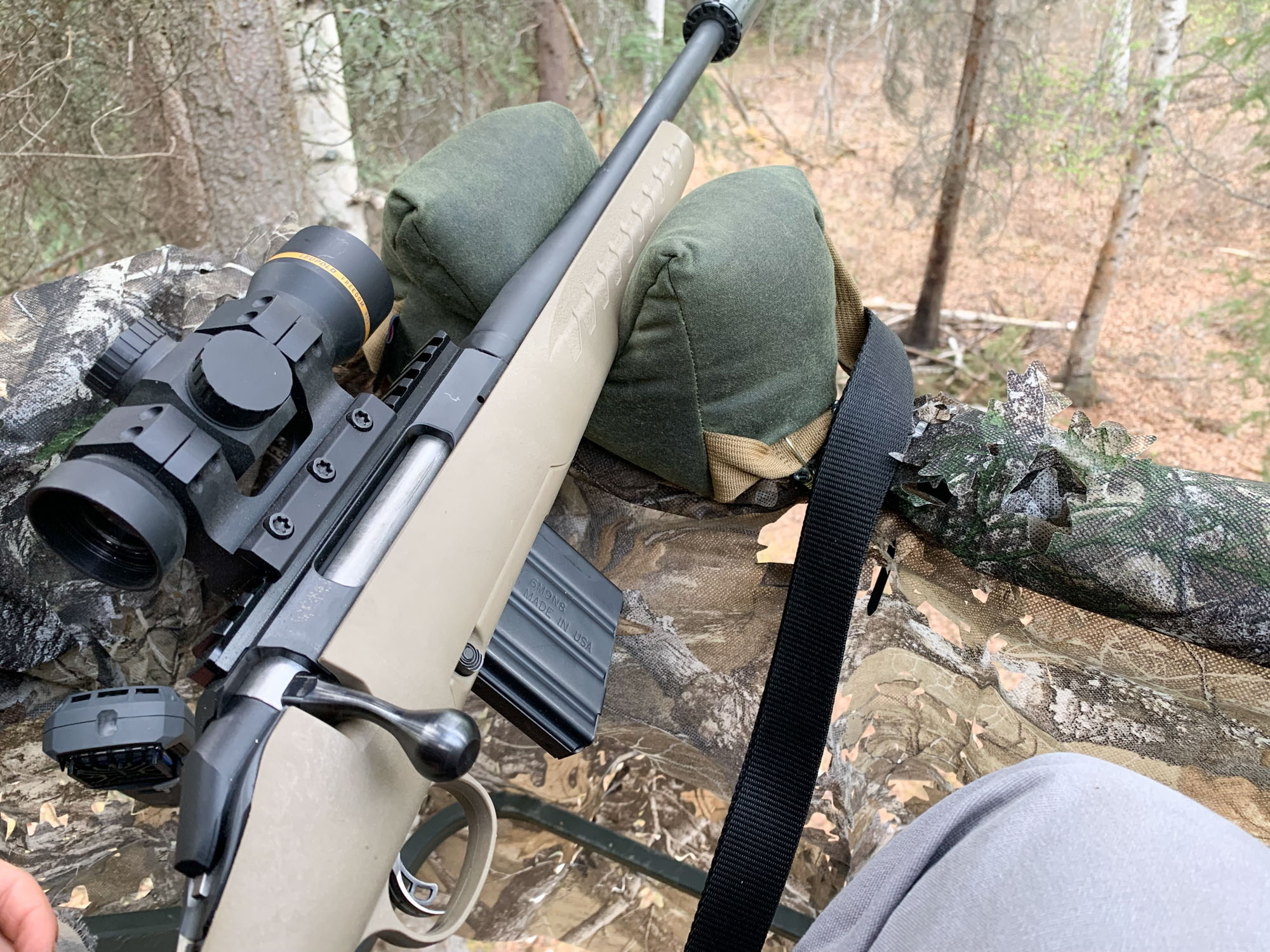
Refine Technique with Dry Fire
The best way to figure out what works is dry fire practice. Set up your bag and rifle however you like and then mess around with your technique to see what works to minimize the wobble in your sight picture and during your trigger break.
There are too many variables for there to be a single “best” technique. Light rifles behave differently than heavy rifles. Bags filled with sand are markedly different than those with lighter fill.
Experiment with the amount of pressure you’re applying to the stock with your shoulder, trigger hand and support hand. The crosshairs in your scope will tell you how you’re doing. Be sure to pick an aiming point that’s small enough so that if your technique gets sloppy you see it in the optic.
Frequent practice will also allow you to deploy the bag and get set up more rapidly. At some point while practicing you should start timing yourself, so that when the moment of truth arrives in the field, you’ll be ready to rise to the challenge.
Tweak Your Fill and Fill Levels
One last pointer: Most bags are filled tighter than your uncle’s gut after Thanksgiving dinner. Rarely is this optimal.
Assuming your bag has an accessible loading port—always a good feature in a shooting bag—try removing a portion of the fill and seeing how it responds. As a rule of thumb, bags tend to handle better when filled to 75 percent capacity—but don’t be afraid to cut the fill down to two-thirds while experimenting.
The type of fill makes a huge difference as well. If you don’t mind the weight, heavy sand tends to be the most solid, though it can lead to problems when wet.
Plastic beads are a cheap way to go, but they tend to slip and slide and cut down on the stability of the shot by a significant amount.
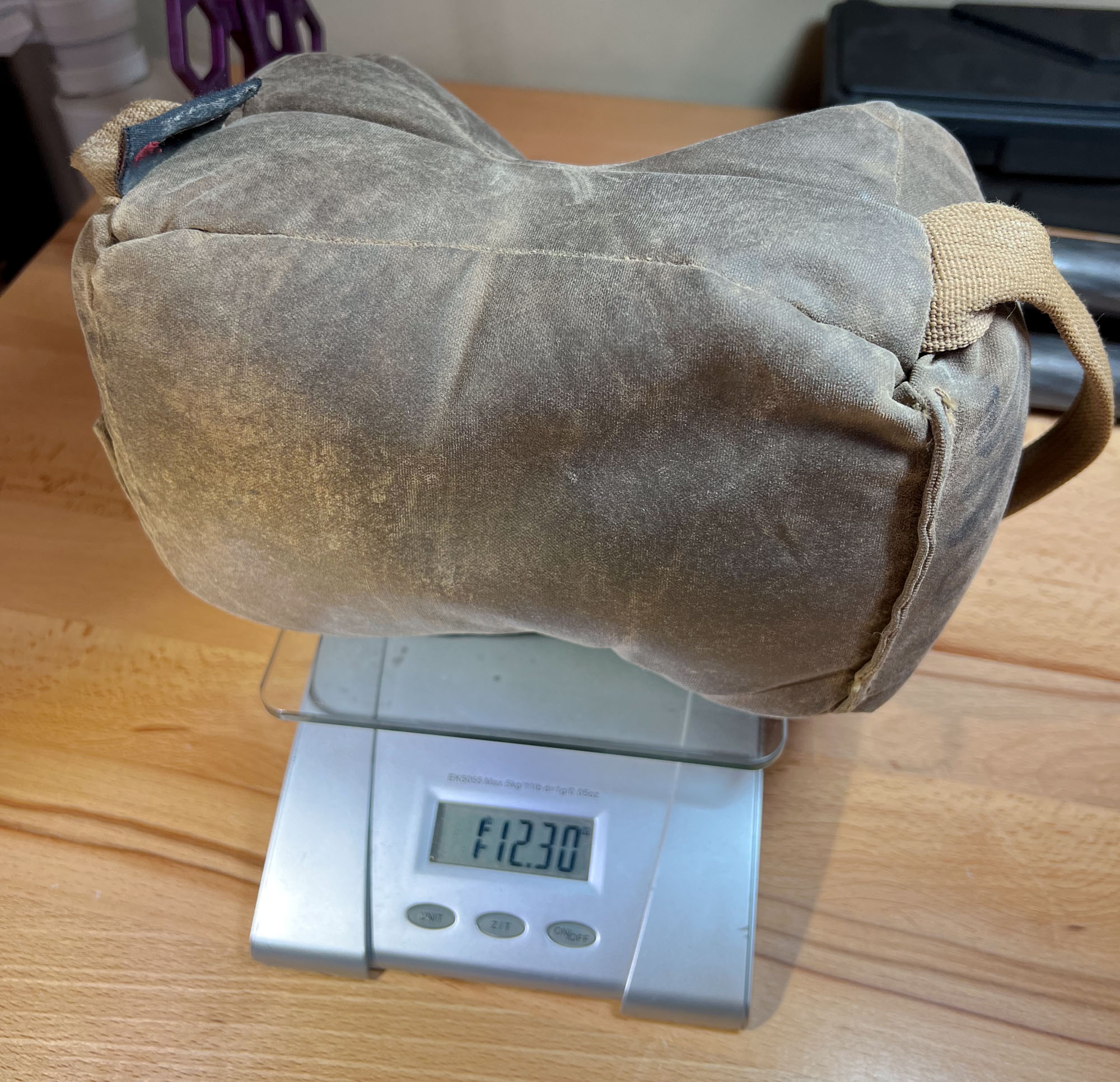
I’ve become a huge fan of Git-Lite, which is a premium lightweight fill that offers a lot of stability. While it isn’t cheap, it works. For any type of serious hunting application or for precision shooting while on the move, nothing compares.
It has become the go-to fill for all our specialized military units in short order and is the fill of choice for elite long-range shooters who don’t want to deal with sand.
If heavy sand is your jam, there are a lot of sources you can turn to. One good place to check is Bruno Shooters Supply which has a fine-grain heavy sand. Another type of sand to consider is sand blasting sand, which can be ordered online or found at hardware stores.
Best Shooting Bags: Reviews & Recommendations
Best Overall: Armageddon Gear Shmedium Game Changer with Git-Lite
Key Features
- Weight: 1.75 pounds
- Dimensions: 8 x 5 x 5 inches
- Price: $142
Pros
- Excellent stability for size
- Lightweight
- Versatile
Cons
- Not cheap
Whenever I travel with a gun, this bag travels with me. I’ve used it in competition, on backcountry sheep hunts, and as a pillow during mid-day siestas while chasing elk. At this point I’ve lost count of how many shots I’ve used it to make on game and distant steel.
This specific model—mid-sized, made of waxed cotton canvas, containing lightweight Git-Lite fill—is the most versatile configuration. At just three-quarters of a pound it is always worth toting along. Together with the full-sized Game Changer it is the most popular shooting bag in precision rifle competitions.
Early iterations of this bag used different materials in their construction, but through trial and error the waxed canvas bag with the heavy-duty nylon handles has proved to be the best. It provides tremendous stability in myriad shooting positions and works well from nearly any support you encounter.
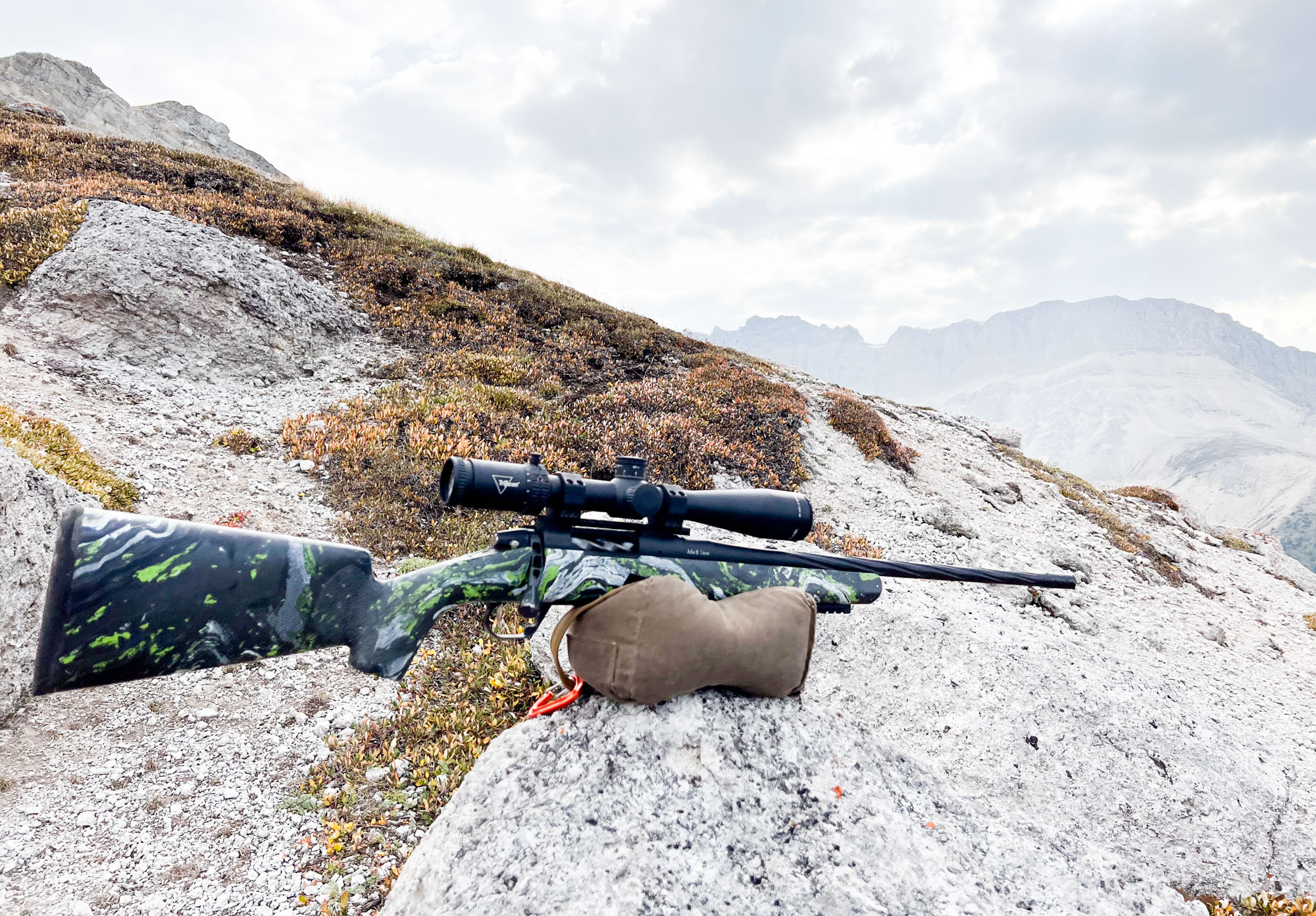
The bag is extremely durable, but it is possible to tear it on rocks and thorns. So I always carry gear patch tape to deal with any abrasions.
Note that you can order this bag with heavy sand if you want the extra stability and don’t mind hauling the weight.
Best Squeeze Bag: Rifles Only Rear Bag
Key Features
- Dimensions: 7 x 5 x 1.25 inches
- Weight: 1.18 pounds
- Price: $30
Pros
- Versatile
- Affordable
Cons
- None
This bag might seem basic, but it is the result of countless hours and thousands of rounds of testing and refinement. The Rifles Only Rear Bag is just that—a rear bag that goes under the stock of the rifle to lend stability to the shot.
It comes with a nylon strap that runs lengthwise down the middle of the long edge. The shooter threads their hand between the strap and bag to maintain control over the bag while applying more or less pressure to fine-tune the rifle’s aim. The strap also secures the bag in the shooter’s hand while on the move.
The bag incorporates a corner loop to secure it to a carabiner. If you get one I strongly suggest you do what I do and write your name on it in indelible marker to prevent it from walking when your “buddies” realize how useful it is.
Best Pump Pillow: Wiebad Modular Pump Pillow
Key Features
- Weight : 0.5 pounds
- Dimensions: 7 × 9 × 6 inches
- Colors: Black, Coyote Brown, MultiCam, MultiCam Black, OD Green
- Price: $60
Pros
- Light
- Versatile
- Excellent positional support
Cons
- Not meant to be a dedicated rear bag
Wiebad was among the first bag makers in the modern precision rifle era to make a splash. The pump pillow concept is one they pioneered.
When setting up on a barricade one way to gain stability is to fill the spaces where your rifle and body lack support. Those spaces are where the pump pillow comes in. They excel at making particularly awkward positions more stable.
Often, they go under the arm supporting the rifle’s fore-end, resting on either the thigh or the barricade itself. They can be placed under the chest when shooting from a high prone position. They can go underneath your butt when kneeling. Their versatility is limited only by your imagination.
The Modular Pump Pillow is an empty zippered container that you can fill with a sweatshirt, rain jacket, bagged lunch, dirty laundry, or whatever else you want. It has two elastic straps to secure the bag to your arm, leg, or rifle. It comes with a plastic carabiner to attach to your gear.
If the burden of filling it yourself is more than you can handle, purchase Wiebad’s original pre-filled model.
Best Budget: Allen Company Outdoor Rifle Rest
Key Features
- Dimensions: 11 x 5 x 5.5 inches
- Weight: 2.2 pounds
- Price: See Price
Pros
- Affordable
- Portable
Cons
- Works well off a bench, but lacks utility for general field use
This is a basic, no-frills pair of shooting bags that will work to sight in a rifle and confirm zero before hunting season.
It isn’t as technical as the other bags in this roundup and doesn’t pretend to offer the same level of stability and versatility as they do. But it is the kind of bag that’s ideal to bring to the range for general shooting and to keep in your kit when you head to hunt camp.
If shooting for maximum precision is your goal, you’ll be better served investing in a higher-quality system. But for day-to-day shooting tasks and plinking this is a budget-friendly option.
Best Ultralight: Short Action Precision Lightweight Bag
Key Features
- Dimensions: 7 x 4.5 x 3 inches
- Weight: 5 ounces
- Price: $45
Pros
- Ultralight
- Clips to rifle
Cons
- Works best as a rear support

Typically, I’ll clip this tiny bag into a QD cup on my butt stock and won’t think about it again until it is time to shoot. This bag is so light and unobtrusive that I forget it is even there. But when it is time to make a shot, it can be a lifesaver.
Its small size means it works best as a rear support underneath the stock, but it does have enough real estate that you can lay it flat on a rock and shoot off it that way in a pinch. The best way to use it, however, is in conjunction with a bipod.
Its rectangular footprint lets you orient in a variety of ways to accommodate different scenarios, while its light weight makes it perfect for mountain hunts.
Best for Benchrest: Edgewood Original Rear Bag
Key Features
- Dimensions: 6 by 8 inches
- Leather sides
- Heavy nylon top and ears
- Price: From $172
Pros
- Excellent stability
- Precise tracking
Cons
- Expensive
- Has 3- to 4-week delivery time
Edgewood makes a number of bags for the dedicated bench shooter, but their most popular remains the Original Real Bag. Even with the original bag, however, there are many varieties to choose from. You can specify bag height (From 2.5 inches with the extra short to 4 inches for the tall. Standard is 3 inches.); spread of the ears (3/8 inch being most common, but 3/16 inch and ¾ in as options); and ear material (Cordura or slick).
Best Rifle-Mounted: Gray Ops Mini Gun Plate V2 and Mini Plate Pad
Mini Gun Plate V 2 Key Features
- Dimensions: 6.75 x 4.5 inches
- Weight: 10.8 ounces (22.8 ounces with optional brass weights)
- Price: $175
Mini Plate Pad Key Features
- Dimensions: 8 x 5 x 2 inches
- Weight: 2 pounds (with beads); 4 pounds (with sand)
- Price: $73
Pros
- Excellent stability on rifle fore-end
- Hands-free operation
Cons
- Requires ARCA rail to attach
- Expensive
This one is a two-parter, consisting of the plate and bag, which are sold individually by Gray Ops. (You can also get the bag directly from Armageddon Gear.) The V2 plate is an updated version of a Gray Ops system which I’ve been running for years.
The plate and bag attach to each other and then the plate can be affixed to an ARCA rail on your rifle stock. This allows you to run your rifle with a support bag in a hands-free manner, helping you navigate precision rifle stages in less time.
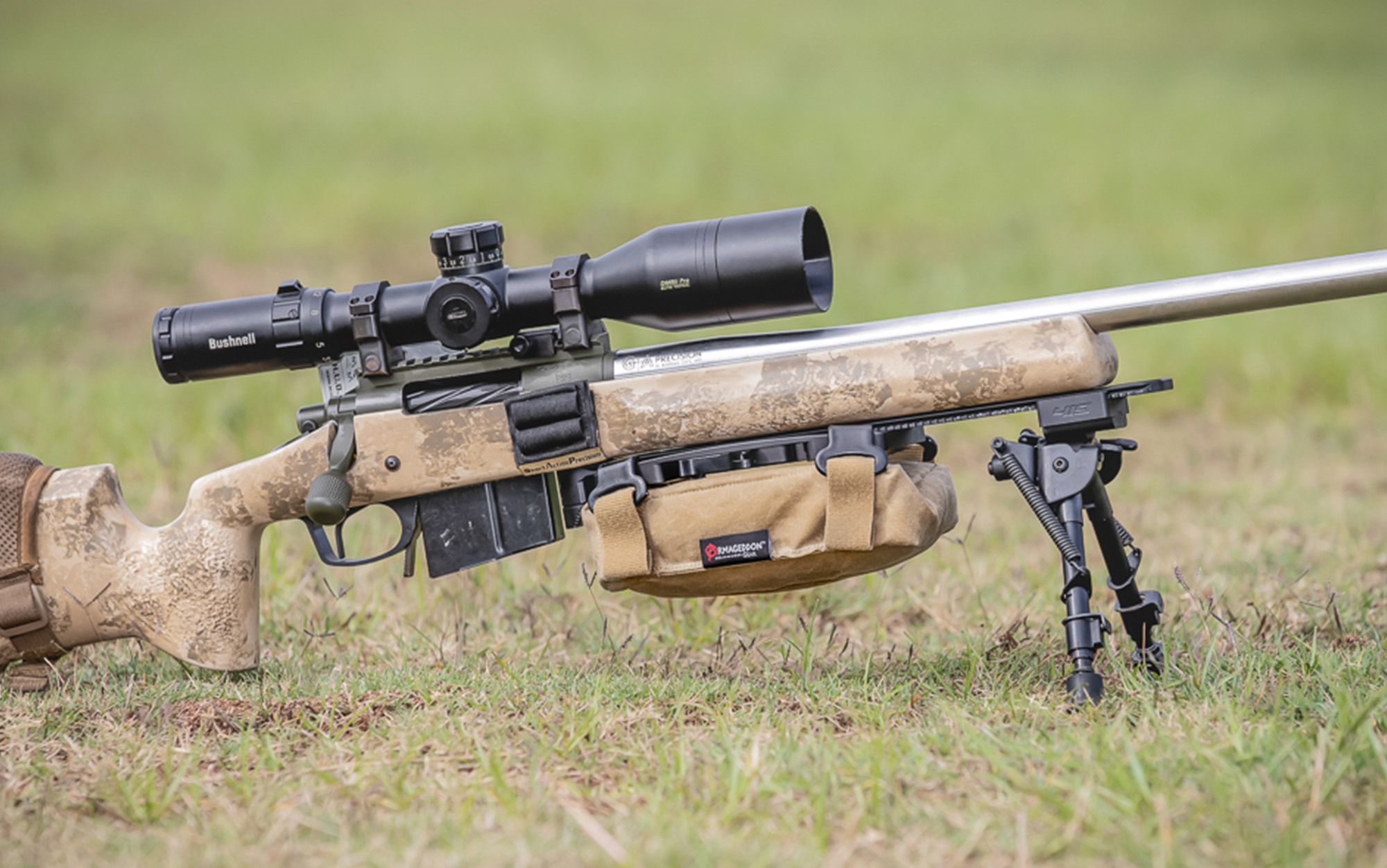
The other advantage of the pad is its low height. That lets you maneuver the rifle in and out of constrained spaces, like cutout portholes and between the rails of a cattle gate, with sufficient clearance.
Another option is to run the plate with the Shmedium Game Changer. Gray Ops makes a brassier that slings around the Shmedium and holds it in place.
Granted, this is a fairly specialized bag, but for competitors looking to gain an edge it is a godsend for some scenarios.
Best for Use in Vehicle: Weibad DRC Fortune Cookie
Key Features
- Weight: 6.2 pounds
- Dimensions: 8 × 5 × 7 inches
- Colors: Black, Coyote Brown, MultiCam, MultiCam Black, OD Green
- Price: $80
Pros
- Conforms easily to narrow surfaces
- Versatile
Cons
- None
The circumstances under which a person can shoot from a vehicle are narrow and specific. For big game hunting most, but not all, states forbid the practice. But for shooting varmints and predators, and with the growing popularity of pest control at night, shooting from a pickup or a side-by-side is not unusual in freedom-loving states.
The Weibad DRC Fortune Cookie is ideally shaped to drape over a truck door, partially rolled down window, side-view mirror, or roll cage bar. It also works well off a tailgate or hood, as long as you remain aware of the difference between your rifle’s bore and the scope’s line of sight.
The Fortune Cookie isn’t limited to shooting from vehicles, of course. Its layout works well for general shooting tasks too.
Great General Design: Satterlee Bone Bag
Key Features
- Dimensions:
- Weight: 2 pounds (with Git-Lite), 11 pounds (heavy sand)
- Price: $139
Pros
- Versatile
Cons
- Expensive
This bag is not unlike the Armageddon Gear Shemedium in terms of its footprint, weight, general design, and utility. Designed by renowned shooter and match director Scott Satterlee, the Bone Bag is a versatile support that transports easily (it only weighs two pounds when filled with Git-Lite), is adaptable to a variety of shooting positions, and is rugged.
With a basic plastic bead, the price starts at $139. Heavy sand boosts the price to $146, and with the premium Git-Lite fill it costs $167.
The bag is made of waxed canvas, comes in a couple different color patterns (orange/brown and brown/brown), and has a no-leak loading port that seals with Velcro that can be used to customize the quantity of fill.
Best Minimalist Rear Bag: Long Shot Precision Small Bag
Key Features
- Dimensions: 3.5 x 3.5 inches
- Weight: 13 ounces
- Price: $49
Pros
- Compact
- Portable
- Light
Cons
- Only works as a rear bag
- Doesn’t provide much elevation
This tiny cylinder is simple, lightweight, and functional. It’s made from a combination of suede and Cordura and depending on how you orient the bag you can control the amount of grip or slide between the stock, bag, and shooting surface. Typically, you want to put the suede in contact with the shooting surface and place the slick patch of nylon under your stock.
This bag works especially well in conjunction with an Adjustable Bag Rider. The ABR raises or lowers your stock as needed and the LSP lets you fine-tune the hold.
A Note on Warhorse Development
One bag company not listed here is Warhorse Development, which makes a number of useful bags, such as the cow-udder shaped Clede, Widowmaker, and Butcherboy. The company was recently acquired by MDT and during this transition their products aren’t available, but when they are back in production, we’ll be sure to test them out and include them here if they make the grade.
Read Next: Best Shooting Rests
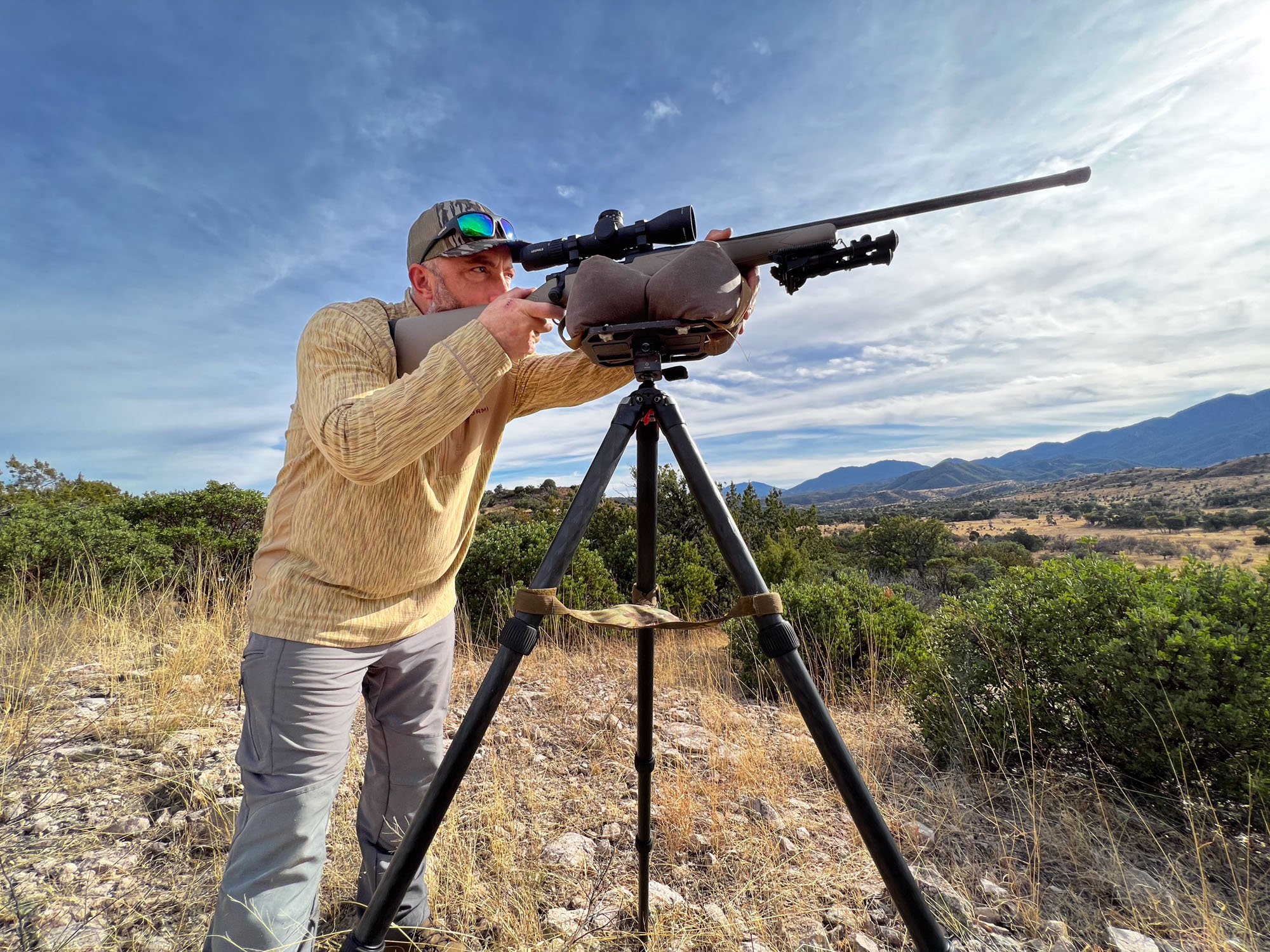
Final Thoughts On Shooting Bags
Shooting bags have become an essential part of the marksman’s kit. Whereas it would have been considered a bit eccentric to carry a specialized shooting bag while hunting just 10 years ago, today it is a more mainstream practice.
If you haven’t jumped on the shooting bag bandwagon, you’re missing out. There are precious few scenarios where a rifle shot can’t be improved with a properly employed shooting bag. It isn’t an exaggeration to state that under some circumstances it can increase a shooter’s effective range by many hundreds of yards.
In view of how lightweight and capable today’s best shooting bags are, getting a good one is not only a good investment, but an excellent bit of insurance should the animal of a lifetime cross your path this fall.
- Best Overall: Armageddon Gear Shmedium Game Changer with Git-Lite
- Best Squeeze Bag: Rifles Only Rear Bag
- Best Pump Pillow: Wiebad Modular Pump Pillow
- Best Budget: Allen Company Outdoor Rifle Rest
- Best Ultralight: Short Action Precision Lightweight Bag
- Best for Benchrest: Edgewood Original Rear Bag
- Best Rifle-Mounted: Gray Ops Mini Gun Plate V2 and Mini Plate Pad
- Best for Use in Vehicle: Weibad DRC Fortune Cookie
- Great General Design: Satterlee Bone Bag
- Best Minimalist Rear Bag: Long Shot Precision Small Bag
